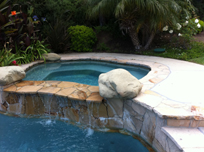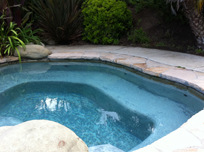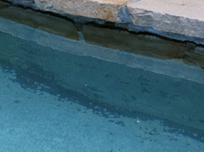High Waterlines, Bad Leaks

 Part of effective watershape construction involves the use of waterproofing agents to create barriers to water intrusion or to make concrete less permeable. But it’s also about keeping water where it belongs, which involves setting proper operating levels for the water.
Part of effective watershape construction involves the use of waterproofing agents to create barriers to water intrusion or to make concrete less permeable. But it’s also about keeping water where it belongs, which involves setting proper operating levels for the water.
For the most part, builders have little trouble with water levels in pools, where it’s generally a good idea to set the level at about the midpoint of the tile line — a decision simplified by the proper use of a typical skimmer. Where things are a bit more challenging is in attached, raised spas, where the level of the weir is the determining factor rather than the waterline tile set inside the spa’s perimeter.
Scenario: Not long ago, I was called by a homeowner to consult on a problem with an existing pool/spa combination. He’d just moved in to the house and had noticed that the deck around the spa was heaving.
I saw the problem immediately: The spillway had been finished with a piece of stone that was approximately three inches thick, which wouldn’t have been a problem except that the notch for the weir had not been lowered at the shotcrete stage to accommodate the thickness of the stone. As a consequence, the level of the spillway was two to three inches higher than it should have been, which placed the effective waterline at the  very top of the spa’s interior tile line, up just beneath the cantilevered stone decking.
very top of the spa’s interior tile line, up just beneath the cantilevered stone decking.
As that intersection was essentially a cold joint where the deck and pool were intended to move independently, there was no waterproofing at that point. So water was seeping in over the bond beam and wicking through the mortar bed between the pool shell  and flagstone decking.
and flagstone decking.
As we all should know, tile is there to accommodate wet/dry conditions at the waterline; moreover, we ought to know that the operating level should be set about three inches below the top of the tile. In this case, however, the water found its level at the joint above the tile line, passed through the mortar bed and eventually saturated the expansive soil beneath the deck, causing it to lift.
Solution: Fixing this sort of problem is pretty straightforward. You need to lower the level of the overflow in one of two ways — either by replacing the thick stone with a thinner material (such as tile) or removing the stone and chipping the gunite down by two or three inches before resetting the stone.
Lesson Learned: While remediation was the simple answer here, a better response would, of course, have been avoiding the situation in the first place by knowing what material was to be used in finishing the weir, and instructing the shotcrete crew to set the notch in the spa wall to accommodate the thickness of the stone. Failing that, the material to finish the wall should have been chosen based on the position of the spillway.
Ultimately, the problem in the case above (as in so many others) boils down inexperience and a lack of proper project management.
Scott Cohen is president and supervising designer of The Green Scene, an outdoor design and construction firm based in Northridge, Calif. He provides consultation for clients nationwide and gives seminars on designing landscapes, swimming pools and outdoor kitchens. For more information, go to www.greenscenelandscape.com.









